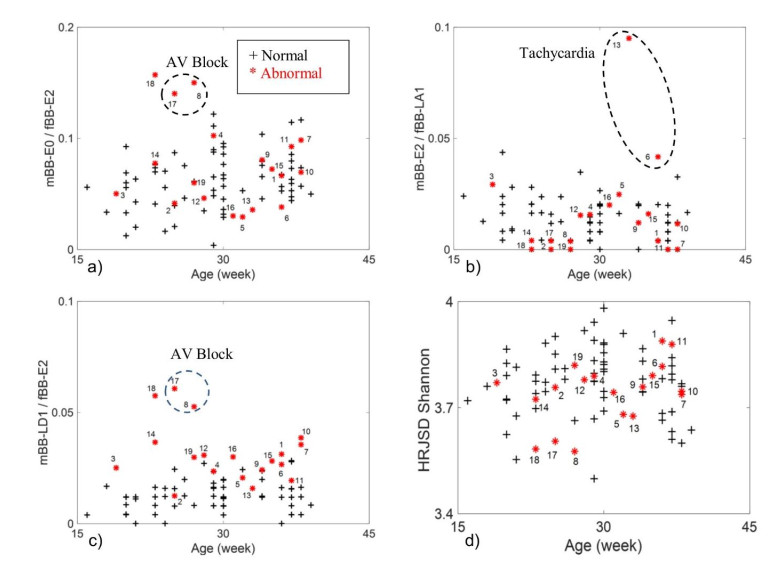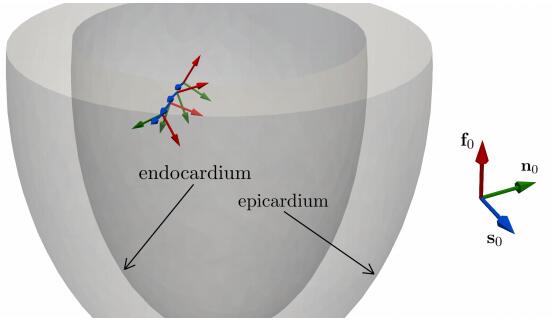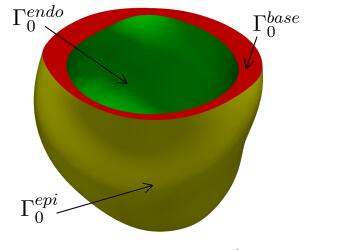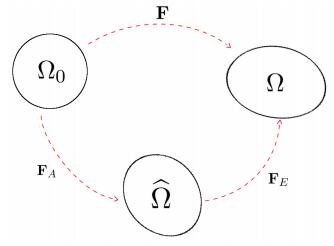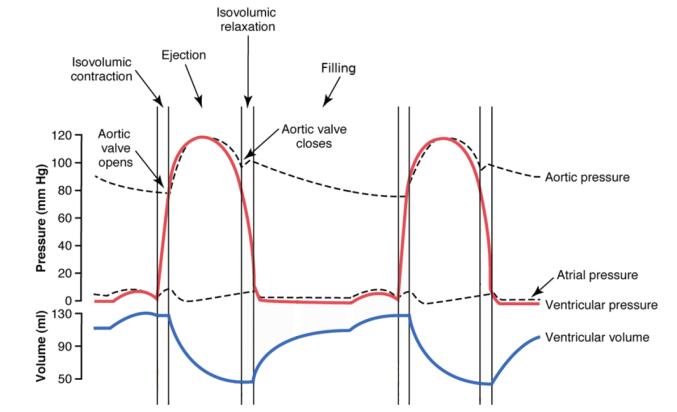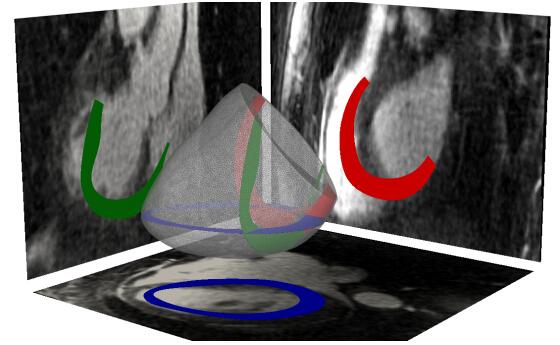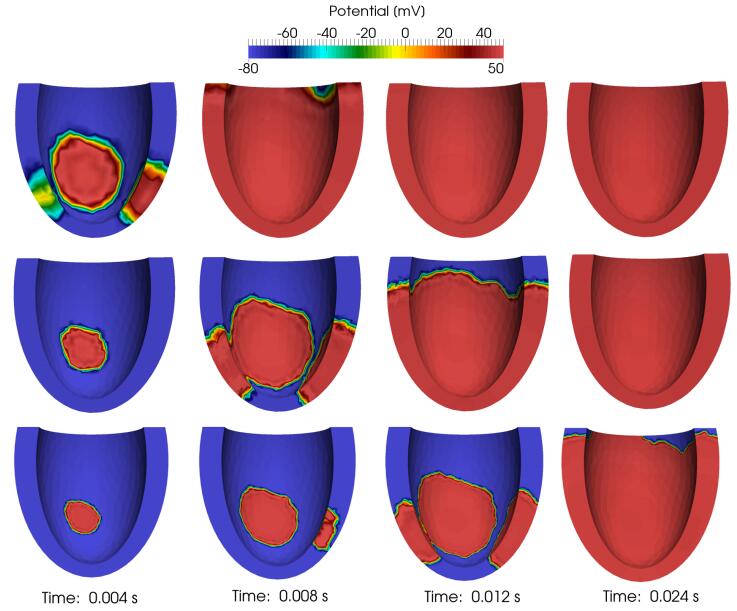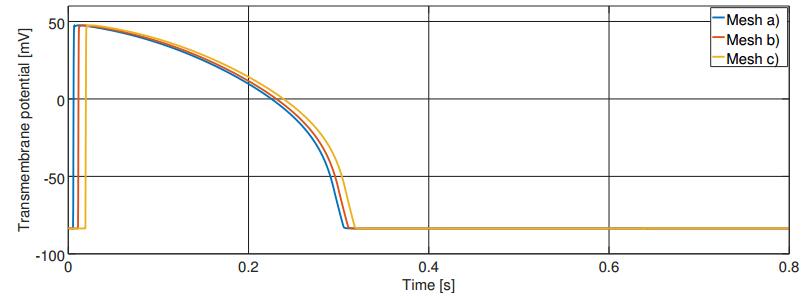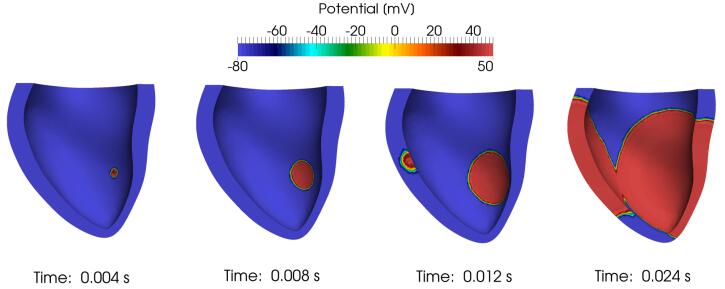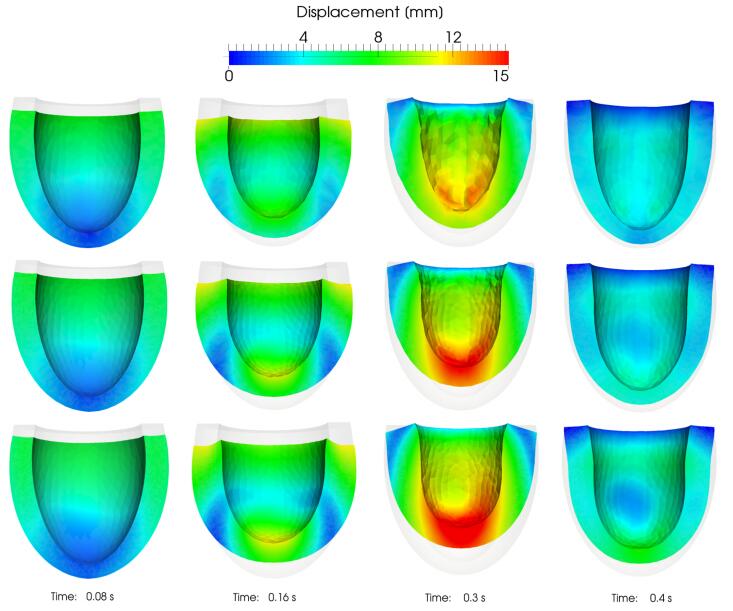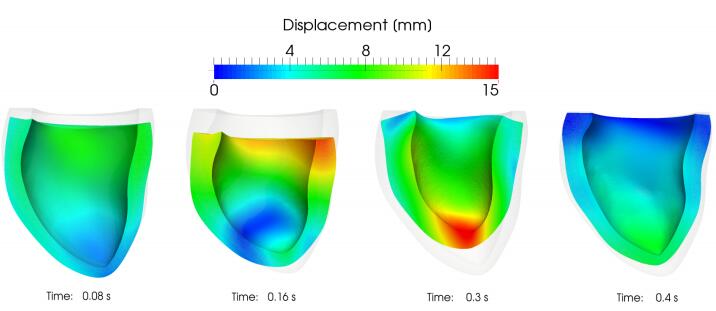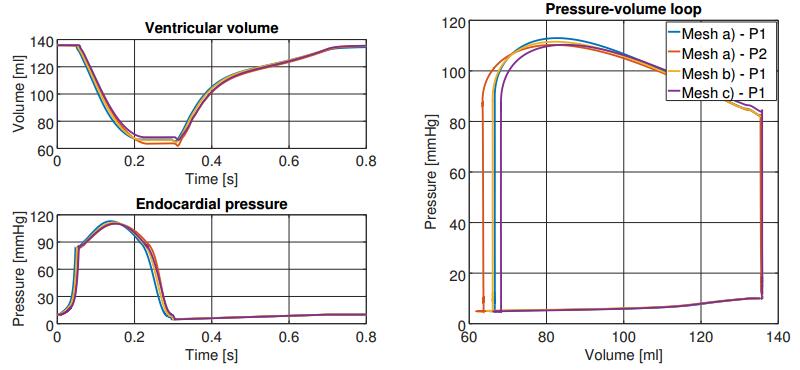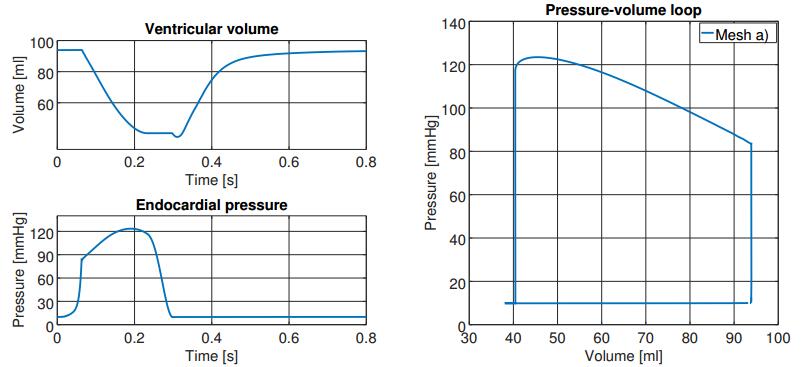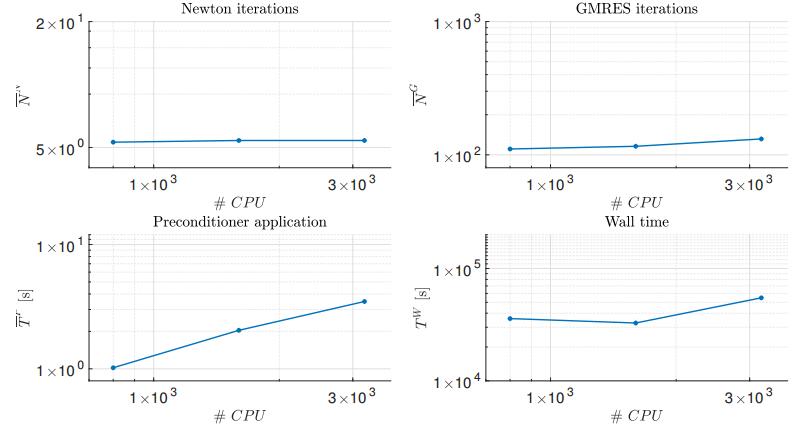|
[1]
|
Aliev RR, Panfilov AV (1996) A simple two-variable model of cardiac excitation. Chaos Soliton Fract 7: 293–301. doi: 10.1016/0960-0779(95)00089-5

|
|
[2]
|
Ambrosi D, Arioli G, Nobile F, et al. (2011) Electromechanical coupling in cardiac dynamics: the active strain approach. SIAM J Appl Math 71: 605–621. doi: 10.1137/100788379

|
|
[3]
|
Ambrosi D, Pezzuto S (2012) Active stress vs. active strain in mechanobiology: constitutive issues. J Elasticity 107: 199–212.
|
|
[4]
|
Augustin CM, Neic A, Liebmann M, et al. (2016) Anatomically accurate high resolution modeling of human whole heart electromechanics: a strongly scalable algebraic multigrid solver method for nonlinear deformation. J Comput Phys 305: 622–646. doi: 10.1016/j.jcp.2015.10.045

|
|
[5]
|
Baillargeon B, Rebelo N, Fox DD, et al. (2014) The living heart project: a robust and integrative simulator for human heart function. Eur J Mech-A/Solids 48: 38–47. doi: 10.1016/j.euromechsol.2014.04.001

|
|
[6]
|
Barbarotta L (2014) A mathematical and numerical study of the left ventricular contraction based on the reconstruction of a patient specific geometry. Master thesis, Politecnico di Milano, Italy.
|
|
[7]
|
Barbarotta L, Rossi S, Dedè L, et al. (2017) Numerical validation of a transmurally heterogeneous orthotropic activation model for ventricular contraction. MOX report, Politecnico di Milano 62/2017.
|
|
[8]
|
Batterman R (2013) The tyranny of scales. Oxford Handbook of The Philosophy of Physics, 256–286.
|
|
[9]
|
Bendahmane M, Bürger R, Ruiz-Baier R (2010) A finite volume scheme for cardiac propagation in media with isotropic conductivities. Math Comput Simulat 80: 1821–1840. doi: 10.1016/j.matcom.2009.12.010

|
|
[10]
|
Bordas R, Grau V, Burton RAB, et al. (2010) Integrated approach for the study of anatomical variability in the cardiac purkinje system: from high resolution MRI to electrophysiology simulation. Annual International Conference of the IEEE Engineering in Medicine and Biology Society 2010: 6793–6796.
|
|
[11]
|
Briggs WL, Henson VE, McCormick SF (2000) A Multigrid Tutorial. SIAM.
|
|
[12]
|
Bueno-Orovio A, Cherry EM, Fenton FH (2008) Minimal model for human ventricular action potentials in tissue. J Theor Biol 253: 544–560. doi: 10.1016/j.jtbi.2008.03.029

|
|
[13]
|
Burman E, Ern A (2003) The discrete maximum principle for stabilized finite element methods. In Numerical Mathematics and Advanced Applications, Springer, 557–566.
|
|
[14]
|
Cai XC, Sarkis M (1999) A restricted additive Schwarz preconditioner for general sparse linear systems. SIAM J Sci Comput 21: 792–797. doi: 10.1137/S106482759732678X

|
|
[15]
|
Causin P, Gerbeau JF, Nobile F (2005) Added-mass effect in the design of partitioned algorithms for fluid-structure problems. Comput Method Appl M 194: 4506–4527. doi: 10.1016/j.cma.2004.12.005

|
|
[16]
|
Cellier FE, Kofman E (2006) Continuous System Simulation. Springer Science & Business Media.
|
|
[17]
|
Chabiniok R, Wang VY, Hadjicharalambous M, et al. (2016) Multiphysics and multiscale modelling, data-model fusion and integration of organ physiology in the clinic: ventricular cardiac mechanics. Interface Focus 6: 15–83.
|
|
[18]
|
Chapelle D, Fernández M, Gerbeau JF, et al. (2009) Numerical simulation of the electromechanical activity of the heart. International Conference on Functional Imaging and Modeling of Heart 5528: 357–365. doi: 10.1007/978-3-642-01932-6_39

|
|
[19]
|
Cheng A, Langer F, Rodriguez F, et al. (2005) Transmural cardiac strains in the lateral wall of the ovine left ventricle. Am J Physiol-Heart C 288(4): H1546–H1556.
|
|
[20]
|
Colli Franzone P, Pavarino LF, Savaré G (2006) Computational electrocardiology: mathematical and numerical modeling. In Complex Systems in Biomedicine, Springer, 187–241.
|
|
[21]
|
Colli Franzone P, Pavarino LF, Scacchi S (2014) Mathematical Cardiac Electrophysiology, Springer.
|
|
[22]
|
Costabal FS, Concha FA, Hurtado DE, et al. (2017) The importance of mechano-electrical feedback and inertia in cardiac electromechanics. Comput Method Appl M 320: 352–368. doi: 10.1016/j.cma.2017.03.015

|
|
[23]
|
Coupé P, Manjón JV, Fonov V, et al. (2011) Patch-based segmentation using expert priors: Application to hippocampus and ventricle segmentation. NeuroImage 54: 940–954. doi: 10.1016/j.neuroimage.2010.09.018

|
|
[24]
|
Dal H, Göktepe S, Kaliske M, et al. (2011) A three-field, bi-domain based approach to the strongly coupled electromechanics of the heart. Proceedings in Applied Mathematics and Mechanics 11: 931–934. doi: 10.1002/pamm.201110442

|
|
[25]
|
Dal H, Göktepe S, Kaliske M, et al. (2013) A fully implicit finite element method for bidomain models of cardiac electromechanics. Comput Method Appl M 253: 323–336. doi: 10.1016/j.cma.2012.07.004

|
|
[26]
|
Deparis S, Forti D, Gervasio P, et al. (2016) INTERNODES: an accurate interpolation-based method for coupling the Galerkin solutions of pdes on subdomains featuring non-conforming interfaces. Comput Fluids 141: 22–41. doi: 10.1016/j.compfluid.2016.03.033

|
|
[27]
|
Deparis S, Forti D, Grandperrin G, et al. (2016) FaCSI: A block parallel preconditioner for fluid-structure interaction in hemodynamics. J Comput Phys 327: 700–718. doi: 10.1016/j.jcp.2016.10.005

|
|
[28]
|
Doll S, Schweizerhof K (2000) On the development of volumetric strain energy functions. J Appl Mech 67: 17–21. doi: 10.1115/1.321146

|
|
[29]
|
Dupraz M, Filippi S, Gizzi A, et al. (2015) Finite element and finite volume-element simulation of pseudo-ECGs and cardiac alternans. Math Meth Appl Sci 38: 1046–1058. doi: 10.1002/mma.3127

|
|
[30]
|
Eriksson TSE, Prassl AJ, Plank G, et al. (2013) Influence of myocardial fiber/sheet orientations on left ventricular mechanical contraction. Math Mech Solids 18: 592–606. doi: 10.1177/1081286513485779

|
|
[31]
|
Fedele M (2014) A patient specific aortic valve model based on moving resistive immersed surfaces. Master thesis, Politecnico di Milano, Italy.
|
|
[32]
|
Fedele M, Faggiano E, Barbarotta L, et al. (2015) Semi-automatic three-dimensional vessel segmentation using a connected component localization of the region-scalable fitting energy. In 2015 9th International Symposium on Image and Signal Processing and Analysis (ISPA), 72–77.
|
|
[33]
|
Formaggia L, Quarteroni A, Veneziani A (2010) Cardiovascular Mathematics: Modeling and Simulation of the Circulatory System, volume 1. Springer Science & Business Media.
|
|
[34]
|
Forti D (2016) Parallel algorithms for the solution of large-scale fluid-structure interaction problems in hemodynamics. PhD thesis, EPFL, Switzerland.
|
|
[35]
|
Forti D, Bukac M, Quaini A, et al. (2017) A monolithic approach to fluid-composite structure interaction. J Sci Comput 72: 396–421. doi: 10.1007/s10915-017-0363-5

|
|
[36]
|
Gee MW, Siefert CM, Hu JJ, et al. (2006) ML 5.0 smoothed aggregation users guide. Technical report, Technical Report SAND2006-2649, Sandia National Laboratories.
|
|
[37]
|
Gervasio P, Saleri F, Veneziani A (2006) Algebraic fractional-step schemes with spectral methods for the incompressible Navier-Stokes equations. J Comput Phys 214: 347–365. doi: 10.1016/j.jcp.2005.09.018

|
|
[38]
|
Göktepe S, Kuhl E (2010) Electromechanics of the heart: a unified approach to the strongly coupled excitation-contraction problem. Comput Mech 45: 227–243. doi: 10.1007/s00466-009-0434-z

|
|
[39]
|
Gordon AM, Huxley AF, Julian FJ (1966) The variation in isometric tension with sarcomere length in vertebrate muscle fibres. J Phys 184: 170–192.
|
|
[40]
|
Guccione JM, McCulloch AD (1991) Finite element modeling of ventricular mechanics. In Theory of Heart, Springer, 121–144.
|
|
[41]
|
Guccione JM, McCulloch AD, Waldman LK (1991) Passive material properties of intact ventricular myocardium determined from a cylindrical model. J Biomech Eng-Tasme 113: 42–55. doi: 10.1115/1.2894084

|
|
[42]
|
Haralick RM, Shapiro LG (1985) Image segmentation techniques. Comput Vis Graph Imag Proc 29: 100–132. doi: 10.1016/S0734-189X(85)90153-7

|
|
[43]
|
Heroux MA, Bartlett RA, Howle VE, et al. (2005) An overview of the Trilinos project. ACM T Math Software 31: 397–423. doi: 10.1145/1089014.1089021

|
|
[44]
|
Hirschvogel M, Bassilious M, Jagschies L, et al. (2017) A monolithic 3D-0D coupled closed-loop model of the heart and the vascular system: experiment-based parameter estimation for patient-specific cardiac mechanics. Int J Numer Meth Bio 33.
|
|
[45]
|
Hodgkin AL, Huxley AF (1952) A quantitative description of membrane current and its application to conduction and excitation in nerve. J Phys 117: 500–544.
|
|
[46]
|
Holzapfel GA, Ogden RW (2009) Constitutive modelling of passive myocardium: a structurally based framework for material characterization. Philos T R Soc A 367: 3445–3475. doi: 10.1098/rsta.2009.0091

|
|
[47]
|
Hsu MC, Bazilevs Y (2011) Blood vessel tissue prestress modeling for vascular fluid-structure interaction simulation. Finite Elem Anal Des 47: 593–599. doi: 10.1016/j.finel.2010.12.015

|
|
[48]
|
Hunter PJ, Nash MP, Sands GB (1997) Computational electromechanics of the heart. Comput Bio Heart 12: 347–407.
|
|
[49]
|
Isgum I, Staring M, Rutten A, et al. (2009) Multi-atlas-based segmentation with local decision fusion – application to cardiac and aortic segmentation in CT scans. IEEE T Med Imaging 28: 1000–1010. doi: 10.1109/TMI.2008.2011480

|
|
[50]
|
Katz AM (2010) Physiology of the Heart. Lippincott Williams & Wilkins.
|
|
[51]
|
Keyes DE, McInnes LC, Woodward C, et al. (2013) Multiphysics simulations: Challenges and opportunities. Internat J High Perform Comput App 27: 4–83. doi: 10.1177/1094342012468181

|
|
[52]
|
Knisley SB, Trayanova N, Aguel F (1999) Roles of electric field and fiber structure in cardiac electric stimulation. Biophys J 77: 1404–1417. doi: 10.1016/S0006-3495(99)76989-4

|
|
[53]
|
Krishnamoorthi S, Sarkar M, Klug WS (2013) Numerical quadrature and operator splitting in finite element methods for cardiac electrophysiology. Int J Numer Meth Bio 29: 1243–1266. doi: 10.1002/cnm.2573

|
|
[54]
|
Land S, Niederer SA, Smith NP (2012) Efficient computational methods for strongly coupled cardiac electromechanics. IEEE T Bio-Med Eng 59: 1219–1228. doi: 10.1109/TBME.2011.2112359

|
|
[55]
|
Lee HY, Codella NCF, Cham MD, et al. (2010) Automatic left ventricle segmentation using iterative thresholding and an active contour model with adaptation on short-axis cardiac MRI. IEEE T Bio-Med Eng 57: 905–913. doi: 10.1109/TBME.2009.2014545

|
|
[56]
|
LeGrice I, Hunter P, Young A, et al. (2001) The architecture of the heart: a data-based model. Philos T R Soc A: Math Phys Engng Sci 359: 1217–1232. doi: 10.1098/rsta.2001.0827

|
|
[57]
|
Luo C, Rudy Y (1991) A model of the ventricular cardiac action potential. Depolarization, repolarization, and their interaction. Circ Res 68: 1501–1526.
|
|
[58]
|
Luo C, Rudy Y (1994) A dynamic model of the cardiac ventricular action potential. I. Simulations of ionic currents and concentration changes. Circ Res 74: 1071–1096.
|
|
[59]
|
Manzoni A, Pagani S, Lassila T (2016) Accurate solution of Bayesian inverse uncertainty quantification problems combining reduced basis methods and reduction error models. SIAM/ASA J UQ 4: 380–412.
|
|
[60]
|
Murray CJL, Ortblad KF, Guinovart C, et al. (2014) Global, regional, and national incidence and mortality for hiv, tuberculosis, and malaria during 1990–2013: a systematic analysis for the global burden of disease study 2013. The Lancet 384: 1005–1070. doi: 10.1016/S0140-6736(14)60844-8

|
|
[61]
|
Nickerson D, Smith N, Hunter P (2005) New developments in a strongly coupled cardiac electromechanical model. Europace 7: 118–127. doi: 10.1016/eupace/7.Supplement_1.118-b

|
|
[62]
|
Niederer SA, Kerfoot E, Benson AP, et al. (2011) Verification of cardiac tissue electrophysiology simulators using an n-version benchmark. Philos T R Soc A 369: 4331–4351. doi: 10.1098/rsta.2011.0139

|
|
[63]
|
Nobile F, Quarteroni A, Ruiz-Baier R (2012) An active strain electromechanical model for cardiac tissue. Int J Numer Meth Bio 28: 52–71. doi: 10.1002/cnm.1468

|
|
[64]
|
Noble D (1962) A modification of the Hodgkin-Huxley equations applicable to purkinje fibre action and pacemaker potentials. J Phys 160: 317–352.
|
|
[65]
|
Nordsletten DA, Niederer SA, Nash MP, et al. (2011) Coupling multi-physics models to cardiac mechanics. Prog Biophys Mol Bio 104: 77–88. doi: 10.1016/j.pbiomolbio.2009.11.001

|
|
[66]
|
Ogden RW (1997) Non-linear elastic deformations. Courier Corporation.
|
|
[67]
|
Omens JH, May KD, McCulloch AD (1991) Transmural distribution of three-dimensional strain in the isolated arrested canine left ventricle. Am J Physiol-Heart C 261: 918–928. doi: 10.1152/ajpheart.1991.261.3.H918

|
|
[68]
|
Patelli AS, Dedè L, Lassila T, et al. (2017) Isogeometric approximation of cardiac electrophysiology models on surfaces: An accuracy study with application to the human left atrium. Comput Method Appl M 317: 248–273. doi: 10.1016/j.cma.2016.12.022

|
|
[69]
|
Pathmanathan P, Bernabeu MO, Niederer SA, et al. (2012) Computational modelling of cardiac electrophysiology: explanation of the variability of results from different numerical solvers. Int J Numer Meth Bio 28: 890–903. doi: 10.1002/cnm.2467

|
|
[70]
|
Pathmanathan P, Mirams GR, Southern J, et al. (2011) The significant effect of the choice of ionic current integration method in cardiac electro-physiological simulations. Int J Numer Meth Bio Engng 27: 1751–1770. doi: 10.1002/cnm.1438

|
|
[71]
|
Pennacchio M, Savaré G, Colli Franzone P (2005) Multiscale modeling for the bioelectric activity of the heart. SIAM J Math Anal 37: 1333–1370. doi: 10.1137/040615249

|
|
[72]
|
Peters J, Ecabert O, Meyer C, et al. (2007) Automatic whole heart segmentation in static magnetic resonance image volumes. MICCAI 1: 402–410.
|
|
[73]
|
Pezzuto S (2013) Mechanics of the heart: constitutive issues and numerical experiments. PhD thesis, Politecnico di Milano, Italy.
|
|
[74]
|
Pezzuto S, Ambrosi D (2014) Active contraction of the cardiac ventricle and distortion of the microstructural architecture. Int J Numer Meth Bio Engng 30: 1578–1596. doi: 10.1002/cnm.2690

|
|
[75]
|
Potse M, Dubé B, Richer J, et al. (2006) A comparison of monodomain and bidomain reaction-diffusion models for action potential propagation in the human heart. IEEE T Bio-Med Eng 53: 2425–2435. doi: 10.1109/TBME.2006.880875

|
|
[76]
|
Quarteroni A, Lassila T, Rossi S, et al. (2017) Integrated heart - coupling multiscale and multiphysics models for the simulation of the cardiac function. Comput Method Appl M 314: 345–407. doi: 10.1016/j.cma.2016.05.031

|
|
[77]
|
Quarteroni A, Manzoni A, Vergara C (2017) The cardiovascular system: Mathematical modelling, numerical algorithms and clinical applications. Acta Num 26: 365–590. doi: 10.1017/S0962492917000046

|
|
[78]
|
Quarteroni A, Sacco R, Saleri F (2010) Numerical Mathematics, volume 37, Springer Science & Business Media.
|
|
[79]
|
Quinn TA, Kohl P (2013) Combining wet and dry research: experience with model development for cardiac mechano-electric structure-function studies. Cardiovasc Res 97: 601–611. doi: 10.1093/cvr/cvt003

|
|
[80]
|
Reese TG, Weisskoff RM, Smith RN, et al. (1995) Imaging myocardial fiber architecture in vivo with magnetic resonance. Magn Reson Med 34: 786–791. doi: 10.1002/mrm.1910340603

|
|
[81]
|
Regazzoni F, Dedè L, Quarteroni A (2017) Active contraction of cardiac cells: a model for sarcomere dynamics with cooperative interactions. MOX report, Politecnico di Milano, 48/2017.
|
|
[82]
|
Rocha BM, Lino B, dos Santos RW, et al. (2009) A two dimensional model of coupled electromechanics in cardiac tissue. In World Congress on Medical Physics and Biomedical Engineering, September 7-12, 2009, Munich, Germany, Springer, 2081–2084.
|
|
[83]
|
Romero D, Sebastian R, Bijnens BH, et al. (2010) Effects of the Purkinje system and cardiac geometry on biventricular pacing: a model study. Ann Biomed Eng 38: 1388–1398. doi: 10.1007/s10439-010-9926-4

|
|
[84]
|
Rossi S (2014) Anisotropic modeling of cardiac mechanical activation. PhD thesis, EPFL, Switzerland.
|
|
[85]
|
Rossi S, Lassila T, Ruiz-Baier R, et al. (2014) Thermodynamically consistent orthotropic activation model capturing ventricular systolic wall thickening in cardiac electromechanics. Eur J Mech A-Solid 48: 129–142. doi: 10.1016/j.euromechsol.2013.10.009

|
|
[86]
|
Rossi S, Ruiz-Baier R, Pavarino LF, et al. (2012) Orthotropic active strain models for the numerical simulation of cardiac biomechanics. Int J Numer Meth Bio 28: 761–788. doi: 10.1002/cnm.2473

|
|
[87]
|
Royse CF, Royse AG (2005) The myocardial and vascular effects of bupivacaine, levobupivacaine, and ropivacaine using pressure volume loops. Anesth Analg 101: 679–687. doi: 10.1213/01.ANE.0000157123.69327.6A

|
|
[88]
|
Ruiz-Baier R, Gizzi A, Rossi S, et al. (2014) Mathematical modelling of active contraction in isolated cardiomyocytes. Math Med Biol 31: 259–283. doi: 10.1093/imammb/dqt009

|
|
[89]
|
Saad Y (2003) Iterative Methods for Sparse Linear Systems. SIAM.
|
|
[90]
|
Satz JE, Kanter HL, Green KG, et al. (1994) Tissue-specific determinants of anisotropic conduction velocity in canine atrial and ventricular myocardium. Circ Res 74: 1065–1070. doi: 10.1161/01.RES.74.6.1065

|
|
[91]
|
Sagawa K (1978) The ventricular pressure-volume diagram revisited. Circ Res 43: 677–687. doi: 10.1161/01.RES.43.5.677

|
|
[92]
|
Sainte-Marie J, Chapelle D, Cimrman R, et al. (2006) Modeling and estimation of the cardiac electromechanical activity. Comput Struct 84: 1743–1759. doi: 10.1016/j.compstruc.2006.05.003

|
|
[93]
|
Sansour C (2008) On the physical assumptions underlying the volumetric-isochoric split and the case of anisotropy. Eur J Mech A-Solid 27: 28–39. doi: 10.1016/j.euromechsol.2007.04.001

|
|
[94]
|
Sengupta PP, Korinek J, Belohlavek M, et al. (2006) Left ventricular structure and function. J Am College Card 48: 1988–2001. doi: 10.1016/j.jacc.2006.08.030

|
|
[95]
|
Simo JC, Taylor RL (1991) Quasi-incompressible finite elasticity in principal stretches. continuum basis and numerical algorithms. Comput Method Appl M 85: 273–310.
|
|
[96]
|
Smith NP, Nickerson DP, Crampin EJ, et al. (2004) Multiscale computational modelling of the heart. Acta Num 13: 371–431. doi: 10.1017/S0962492904000200

|
|
[97]
|
Sugiura S,Washio T, Hatano A, et al. (2012) Multi-scale simulations of cardiac electrophysiology and mechanics using the university of tokyo heart simulator. Prog Biophys Mol Bio 110: 380–389. doi: 10.1016/j.pbiomolbio.2012.07.001

|
|
[98]
|
Tagliabue A, Dedè L, Quarteroni A (2017) Complex blood flow patterns in an idealized left ventricle: a numerical study. Chaos 27: 93939–93964. doi: 10.1063/1.5002120

|
|
[99]
|
Tagliabue A, Dedè L, Quarteroni A (2017) Fluid dynamics of an idealized left ventricle: the extended Nitsche's method for the treatment of heart valves as mixed time varying boundary conditions. Int J Numer Meth Fl 85: 135–164. doi: 10.1002/fld.4375

|
|
[100]
|
Takizawa K, Bazilevs Y, Tezduyar TE (2012) Space-time and ale-vms techniques for patient-specific cardiovascular fluid-structure interaction modeling. Arch Comput Method E 19: 171–225. doi: 10.1007/s11831-012-9071-3

|
|
[101]
|
Takizawa K, Christopher J, Tezduyar TE, et al. (2010) Space-time finite element computation of arterial fluid-structure interactions with patient-specific data. Int J Numer Meth Bio 26: 101–116. doi: 10.1002/cnm.1241

|
|
[102]
|
Ten Tusscher KHWJ, Noble D, Noble PJ, et al. (2004) A model for human ventricular tissue. Am J Physiol-Heart C 286: 1573–1589. doi: 10.1152/ajpheart.00794.2003

|
|
[103]
|
Tezduyar TE, Sathe S, Schwaab M, et al. (2008) Arterial fluid mechanics modeling with the stabilized space-time fluid-structure interaction technique. Int J Numer Meth Fl 57: 601–629. doi: 10.1002/fld.1633

|
|
[104]
|
Toselli A, Widlund OB (2005) Domain decomposition methods: algorithms and theory, volume 34, Springer.
|
|
[105]
|
Trayanova NA (2011) Whole-heart modeling applications to cardiac electrophysiology and electromechanics. Circ Res 108: 113–128. doi: 10.1161/CIRCRESAHA.110.223610

|
|
[106]
|
Trentin C, Faggiano E, Conti M, et al. (2015) An automatic tool for thoracic aorta segmentation and 3D geometric analysis. International Symposium on Image and Signal Processing and Analysis (ISPA), 60–65.
|
|
[107]
|
Usyk TP, LeGrice IJ, McCulloch AD (2002) Computational model of three-dimensional cardiac electromechanics. Comput Vis Sci 4: 249–257. doi: 10.1007/s00791-002-0081-9

|
|
[108]
|
Vergara C, Lange M, Palamara S, et al. (2016) A coupled 3D-1D numerical monodomain solver for cardiac electrical activation in the myocardium with detailed purkinje network. J Computat Phys 308: 218–238. doi: 10.1016/j.jcp.2015.12.016

|
|
[109]
|
Vergara C, Palamara S, Catanzariti D, et al. (2014) Patient-specific generation of the Purkinje network driven by clinicalm easurements of a normal propagation. Med Biol Eng Comput 52: 813–826. doi: 10.1007/s11517-014-1183-5

|
|
[110]
|
Westerhof N, Lankhaar JW,Westerhof BE (2009) The arterial Windkessel. Med Biol Eng Comput 47: 131–141. doi: 10.1007/s11517-008-0359-2

|
|
[111]
|
Wink AM, Roerdink JBTM (2004) Denoising functional MR images: a comparison of wavelet denoising and Gaussian smoothing. IEEE T Med Imaging 23: 374–387. doi: 10.1109/TMI.2004.824234

|
|
[112]
|
Wong J, Kuhl E (2014) Generating fibre orientation maps in human heart models using poisson interpolation. Comput Method Biomec 17: 1217–1226. doi: 10.1080/10255842.2012.739167

|
|
[113]
|
Yin FC, Chan CC, Judd RM (1996) Compressibility of perfused passive myocardium. Am J Physiol-Heart C 271: H1864–H1870. doi: 10.1152/ajpheart.1996.271.5.H1864

|
|
[114]
|
Zheng Y, Barbu A, Georgescu B, et al. (2007) Fast automatic heart chamber segmentation from 3D CT data using marginal space learning and steerable features. International Conference on Computer Vision, 1–8.
|
|
[115]
|
Zhuang X, Rhode KS, Razavi RS, et al. (2010) A registration-based propagation framework for automatic whole heart segmentation of cardiac MRI. IEEE T Med Imaging 29: 1612–1625. doi: 10.1109/TMI.2010.2047112

|









 DownLoad:
DownLoad:









